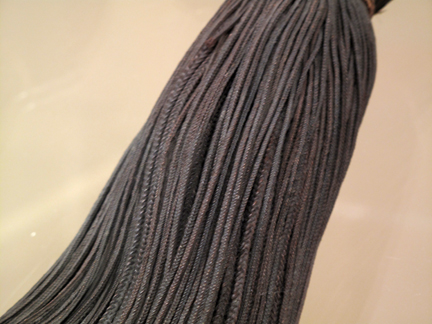Your cart is currently empty!
Unspoken Messages: The Art of the Necklace
Recently ended at the Minneapolis Institute of the Arts was this show of necklaces. A new acquisition is a magnificent necklace from Hawaii, and curators built a gallery of other necklaces in their collection to showcase it.
First, the new Hawaiian necklace:


The Lei Niho Palaoa (necklace) dates to the first half of the 1800s, with a whale tooth ivory hook and hair braid. The hair was donated by family members (it is an honor to do so), braided into one long braid, and looped back and forth to make the mass of braids. The size and quality of this necklace reflects the prominence of the owner.

This is a classic example of a Diné (Navajo) silver squash blossom necklace with a naja at the bottom. These necklaces were and are worn by women and men as ornaments and as a portable form of wealth. From the 20th century.

Clasp detail:

This silver necklace is from the Miao of China, also 20th century. Miao jewelry gives information on a woman’s village and clan affiliation.

This Apsaalooka (Crow) loop necklace is made of hide, glass beads, shell, metal, and plant fiber. It dates to the 1890s.


This French necklace is made of coral and gold wire, and dates to the 19th century.

This necklace is from the Veragaus (of Panama), and is cast gold, dating from the 9th to 15th century. It is likely a man’s necklace, and would have been worn with other gold jewelry to denote social, political, and religious affiliations. Gold was common, so workmanship denotes its value.


This necklace is from the Kuba, of the Democratic Republic of Congo, from the 20th century. It is glass chevrons, and lion’s teeth, and immense. The largest chevron is about 3″ long. Its size and inclusion of teeth shows the owner’s affluence, and is a display of high rank and power.


This is a Gowri Shankaram necklace of the Tamil Nadu (India), from the early 19th century. It is made of rudraksha berries, gold, garnets, and rubies. The clasp and pendant has depictions of Hindu gods, and was given to a temple to show the owner’s piety and devotion.
This is made of shell, tortoise shell, and string, and is from the Solomon Islands, 20th century.


This is from the nomadic Ida ou Semlal of Morocco, part of the Berber group. It’s 20th century, made of silver, amber, glass, stone, shell, and fiber. The necklace is portable wealth, where the components can be used as cash as needed. The large amber nuggets are possibly Baltic.

From the Santo Domingo Pueblo, this 20th century necklace is made of turquoise, coral, and silver.


These are details of a Roman necklace, dating to the 1st to 3rd century, made of glass, stone and ceramic beads, and gold. The beads themselves are Roman and Egyptian. It would have adorned a middle-class woman, and been a prized possession.
4 responses to “Unspoken Messages: The Art of the Necklace”
I like these. They are beautiful adn touch the soul
I love the combination of history and beauty…
i recognize its a few years later ….but thanks for posting these…so completely amazing beautiful and contemporary and relevant all at once…people are amazing creators…. thanks again
The necklaces are really timeless, aren’t they? It is a beautiful collection of work. You’re most welcome.